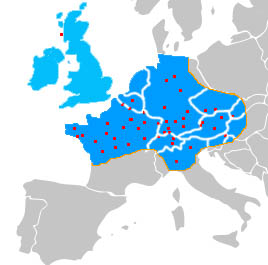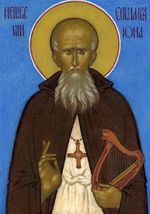Columba: Difference between revisions
(update links and modify slightly) |
(No difference)
|
Revision as of 23:51, 30 May 2007
|
Saint Columba or Saint Colm Cille (December 7, 521 - June 9, 597) sometimes known as St. Columba of Iona was born in County Donegal, Ireland. His name, in Old Irish, means "Dove of the church." He was born into royalty and could himself have possibly become a high king of Ireland. Instead, he chose to give up his royal privileges and become a servant of the King of kings, and a missionary to Scotland. Columba's life was marked by a love for the scriptures, and dedication to their transcription. According to his biographer Adomnan, it was through Columba's prayers in the name of the Lord Jesus Christ that the sick were healed, the dead were raised, visions were seen, prophecies were made and fulfilled, storms were calmed, and water was turned to wine. On one instance, while coming to a meeting regarding his excommunication, one of the clergy members suddenly ran to him, and kissed him reverently. When the rest of the clergy members demanded a response for his actions, he replied:
Birth and Youth
Before his birth, his mother saw an angel who told her that her unborn child was a son who would be "remembered among the Lord's prophets." At that time, it was a common practice for ruling families to find their children a foster home in which to be raised. Columba, however, was sent to be raised by a priest. From an early age he showed a love of the Scriptures, especially the Psalms. He was educated at Moville and Clonard. He became a monk and was ordained a priest. Already there were reports of miracles following his prayers. The fame of the young priest began to grow, and so did the list of the monasteries he had established.
Missionary to Scotland
Legend says that sometime around 560, St Columba hand copied a psalter in the protection of St Finnian of Moville. Saint Finnian demanded to have the copy. St Columba refused. The despute was taken before the high king, Diarmuid, who ruled: "To every cow her calf, and to every book its copy". However, Columba still refused to return the psalter, so Saint Finnian and St. Columba each gathered an army and met at Cúl Dreimhne to resolve the dispute with the sword. While Columba's side was victorious, hundreds of lives were lost in the battle.  The influence of Columba in continental Europe based on ancient manuscripts of Vita Columbae, relics, and commemorations of Columba found in these areas. Map based on research published in "Adomnan's Vita Columbae and the cult of Colum Cille in Contental Europe, Jean-Michel Picard, June 22, 1998, National University of Ireland, Dublin. According to tradition, Columba was sent to Scotland to do penance by converting as many pagans as there were lives lost in the battle of Cúl Dreimhne. Historians do not agree on the accuracy of this tale as some contend that it was his love for the Gospel that took Columba to Scotland. Certainly, in 563, he did set sail for Scotland with twelve fellow missionaries. He was granted land on the island of Iona off the west coast of Scotland and set up his mission headquarters there. There are many stories of miracles and wonders performed by Columba in his work. One tells how he went to see Brude, king of the Picts. Brude did not want to see Columba. He ordered that the city gates be locked against the missionary's entrance. But when Columba prayed, the gates flew open on their own accord. King Brude was so awed that he immediately converted to Christianity. Columba traveled through the Highlands evangelizing and founding churches as far away as Aberdeen. He still had ties to Ireland where he may have founded over a hundred churches. He returned there when necessary to attend church synods. He was a poet and may have written 300 books. Columba was a man of tremendous energry and is said to never have spend an entire hour without studying, reading or preaching. On June 9, 597, at the age of seventy-seven, Columba died peacefully. Some reports say he was making another copy of the Psalter at the time of his death. After his death, Columba's Iona became a place of pilgrimage, and a network of Celtic high crosses marking processional routes developed around his shrine. The Vikings sacked the monastary in 794, and the remaining relics were finally removed in 849 and divided between Alba and Ireland. After the death of Columba, and later after the destruction of the monastary, the Monks who had inhabited the island had no place to return to, so they penetrated deep into Northern Europe, spreading his life story, preaching the gospel, and translating the Bible. By the 1200s, the story and influence of Columba was widespread across Europe, as evidenced by ancient copies of his life story and other relics. However, by the 1400 Columba was all but forgoten as the result of the peasant class being illiterate, and the clergy speaking in latin. Columba's story still remained in the northern British Isles, however, and relics of Columba were carried before Scottish armies in the reliquary made at Iona in the mid-8th century, called the Brechbennoch. O Columba spes Scotorum... "O Columba, hope of the Scots" begins a 13th century prayer in the Antiphoner of Inchcolm, the "Iona of the East".
Vita Columbae
The main source of information about Columba's life is the Vita Columbae by Adomnán, who was a successor of Columba's at the monestary in Iona. Both the Vita Columbae and Bede record Columba's visit to Bridei I of the Picts, King of Fortriu. Whereas Adomnán just tells us that Columba visited Bridei, Bede relates a later, perhaps Pictish tradition, whereby the saint actually converts the Pictish king. Another early source is a poem in praise of Columba, most probably also composed in the course of the 7th century. It consists of 25 stanzas of four verses of seven syllables each. The vita of Columba is also the source of the first known reference to the Loch Ness Monster. According to Adomnan, Columba came across a group of Picts who were burying a man killed by the monster, and saved a swimmer with the sign of the Cross and the imprecation "You will go no further", at which the beast fled terrified, to the amazement of the assembled Picts who glorified Columba's God. Whether or not this incident is true, Adomnan's text specifically states that the monster was swimming in the River Ness, rather than in the lake itself.
Source: Life of Saint Columba, Founder of Hy. Written by Adomnán, ed. William Reeves, ( Edinburgh: Edmonston and Douglas, 1874) This text was taken from the Internet Medieval Source Book. The Sourcebook is a collection of public domain and copy-permitted texts related to medieval and Byzantine history. This specific electronic form of the document is copyright by © Paul Halsall March 1998. Permission is granted for electronic copying, distribution in print form for educational purposes and personal use. No permission is granted for commercial use. As the use on this site is for educational and not commercial purposes, and as the sources has been appropriately cited, it is believed to be appropriate to include the full text of these books on www.believethesign.org
Adomnan of Iona
The following is adapted from BBC's Online History Pages.
Timing
In his teachings on the Church Ages, William Branham mentions that the Church ages overlap each other. A prime example of this is the fact that the Messenger to Thyatira, Columba, lived and died prior to 606 A.D. (which marks the start of the Thyatiran Church Age). Columba, who was known for his dedication to scripture, and for performing his miracles in the name of Lord Jesus Christ, had an unparalelled influence on Christians internationally during the Age of Thyatira through the diffusion of Monks from Iona, and through the distribution of his life story, compiled by the Abbot Adomnan of Iona by the year 700 A.D. Many of the independent Christians during the 1000 years after Columba would follow Columba's template for spreading the Gospel: a dozen men would be sent to a new region, and create a new town and centre of learning from the combined knowledge each posessed (one preacher, one carpenter, etc...). Note: Columba should not be confused with Columbanus, another sixth century monk. |
